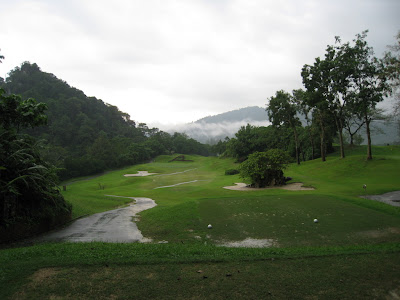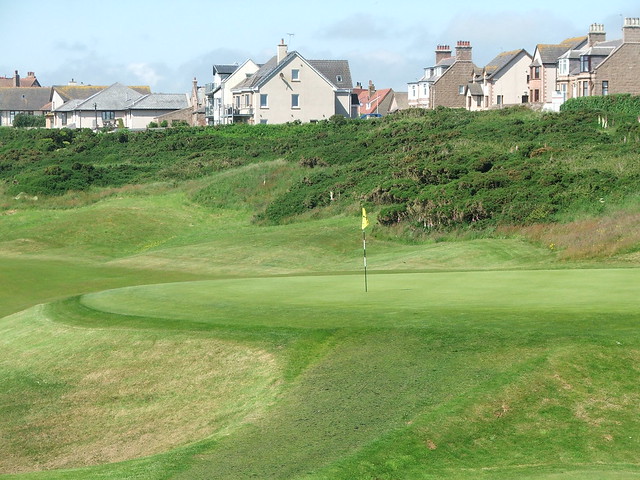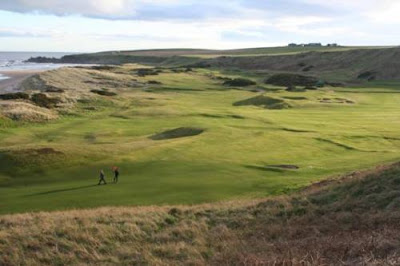It must be noted that my blogger colleague and I did not play in the same group. He was invited to play with a special, elite traveling group. I played with the third member of our trio of friends, each of whom is on a quest to play the world’s top 100 courses. My golfing partner and I flew into Madrid the day before and drove almost 10 hours south to Spain’s southern coast. Spain is a beautiful country – it is very dry and much more mountainous than ever imagined. Our drive took us through the city of Granada, which is home to the famous Alhambra palace. What shocked us most about Granada was the snow capped mountains that framed the city. These are the Sierra Nevada mountains, not unlike the Sierra Nevadas found in this country. Another highpoint of our day-long trip were the roads in Spain. They are real and spectacular. Perfect condition. No potholes, no traffic. Truly a pleasure to drive in this country. We passed seemingly miles of nothing but olive trees. There are more olive trees than people. Kind of like Scotland where sheep far outnumber humans. Refreshing.

Golfing Letdown
So where did things go wrong? First, as we were about to tee off, we asked the starter if it ever rains in the southern part of Spain. It’s probably a question he doesn’t get too often. After all, they don’t name it the Sun Coast for nothing. But it was a very cloudy this day and it looked darker on the horizon. “No, it never rains in Spain,” he confidently said. I was both pleased and relieved as I had left my rain suit and umbrella in my hotel room. By the third hole, the rain was pelting down. So much for Al Roker sitting in the starter house.
Although the rain was an unwelcome surprise, the bigger let down was the Valderrama golf course itself. This is where the big differences between my blogger colleague and I exist. My second shot on the first hole was my first clue. My drive was on the left edge of the fairway with about 160 meters to the green for a second shot. Not a great drive but certainly playable and acceptable to my level of play. But the second shot would require either a low stinger beneath the cork trees that would have to stop suddenly on a tiny green or a high lofty shot that would have to, by luck, ricochet off the cork trees and drop onto the green (see blogger pictures). It was then that I realized this course was built for Seve, not for Steve, Joe or Jim and their 8 to 14 American handicaps.
The second hole was a bit more ridiculous – cork trees in the middle of the fairway. My drive was where it was supposed to be – in the fairway. My reward for hitting the fairway? A punch shot to advance the ball under the trees. I couldn’t get near the green. And of course there was cork trees overhanging parts of the putting surface.
A quick comment on cork trees. They are fascinating. Never saw them before. Yes, they are spongy like a cork. I like cork, especially when it is released from a lovely bottle of Bordeaux. I don’t like cork when it unfairly obstructs my approach shots to green after green.

By the third hole, I said to my playing partner and traveling companion, “I’ve played this course before. It’s called Harbour Town. Hated that tricked up place and it isn’t worthy of being in the top 100.”
As we reached the fourth hole, the rain didn’t let up but the flow of the round did. We were delayed by the slow play of the two groups ahead of us. This gave us the chance to meet up with a lovely married couple and we joined their twosome. He was from Scotland, she was from Ireland. Golf was obviously in their blood. Money was obviously in their pocket as they were members of both Valderrama and Loch Lomond. Both had game but more importantly they were truly informative about their courses in Spain and Scotland. As for the fourth hole itself, it was more of the same. The picture looks nice but even the blogger admits that part of the green is blocked by overhanging trees.
By the time we got to the ninth hole, the rain was teeming down. Kind of like Octomom when her water broke. It was so intense and unexpected, the rain actually sent our Scottish/Irish friends packing. They had had enough. However, after we shook hands to say goodbye, the Scot, seeing my pathetic frame as if I were in a wet-tee shirt contest, offered me his rain suit. I’m not yet comfortable to jump into another man’s trousers but I quickly seized his waterproof jacket. All I had to do at the end of the round was to return it to Al Roker, who would put it in the Scot’s locker. Another reason to love Scotland, I declared.
The rain on the back nine continued. Admittedly, the golf course improved somewhat. But I think you get the idea that trying to bend and shape shots into covered greens gets old fast. My comments and rebuttal, however, wouldn’t be complete without a note about the “iconic seventeenth hole.” Yes, history was here during the 1997 Ryder Cup. My blogger colleague is correct in saying this is an uncharacteristic hole compared to the others because of the lack of overhanging cork trees around the green (perhaps there was an emergency corkage need for some Contador 2005 Benjamin Romeo). But what was most shocking about the 17th hole was the man-made pond in front of the green. Actually, calling it a pond is an injustice to ponds. If you look closely at the blogger’s second picture, you see the “pond’s” pool liner that is covered by sunken green algae. It’s kind of like the neighbor who has an in-the-ground pool but never cleans it. All that was missing was a diving board and a slide.
19th Hole
I didn’t hate Valderrama. As noted, I was very excited to visit Spain for the first time and play this historical course. I was pumped for a course that I thought would exceed expectations. But with the rain in Spain not staying on the plain and a course that doesn’t reward good shots, my Valerrama golfing experience was disappointing. Plus, and this cannot be ignored, at 300 euros plus 60 euros for a cart, the golf set me back about 480 large. Ouch!
What did I like about Valderrama? I like small greens, and small areolas and Valdy had about 18 of them. Plus the course was in beautiful shape. The scenery was just average – there was a lot of real estate. Keep in mind that this is a resort course. Think Harbour Town, Doral, Palm Desert. If you look really hard, you can see the Mediterranean Sea and the tip of the Rock of Gibraltar. Frankly, the views found within the low country of South Carolina (Yeaman’s Hall), cliffs of Bandon Dunes or windmill at Long Island’s National excite me much more. The biggest plus, as it is with all of our trips, was my playing partner. We were soaked yet thirsty. We reveled in our disappointment of the course yet had a lot of fun. The pops we consumed during and mostly after the round are and will always be a key component of any of our trips.
Finally, perhaps the best way to judge a golfing experience is to ask yourself if you would return. This doesn’t mean a second round in a day – that would be too easy, especially if, like my blogger colleague, money is not an issue (his idea of hard times is no salt on his peanuts or drinking 12-year-old Macallan instead of 15-year-old). Would I make another transatlantic flight to Spain just to play Valderrama? I would do – and have done it – for Scotland, Ireland and England. Spain, despite its rugged beauty and the extreme courteousness of its people, is not a place I would return for another golf experience. There are way too many other places I’ve got to play and re-play.
















